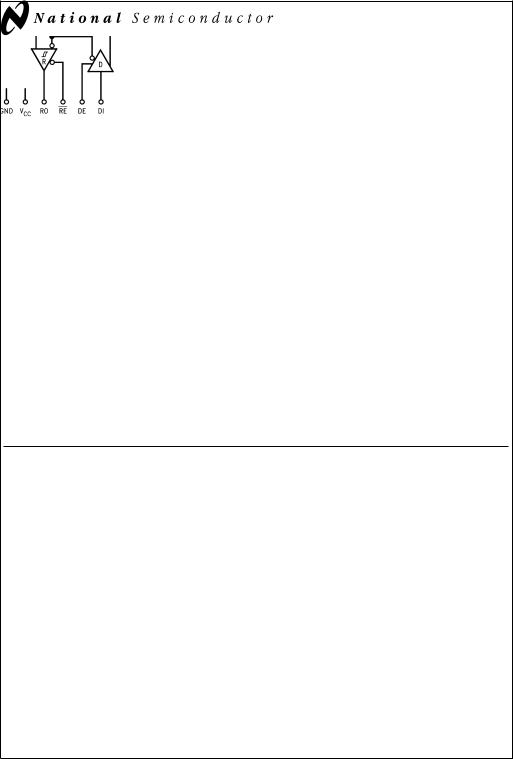NSC DS16F95W-MLS, DS16F95W-MCP, DS16F95MDS, DS16F95MDA, DS16F95J Datasheet
...
June 1998
DS16F95, DS36F95
EIA-485/EIA-422A Differential Bus Transceiver
General Description
The DS16F95/DS36F95 Differential Bus Transceiver is a monolithic integrated circuit designed for bidirectional data communication on balanced multipoint bus transmission lines. The transceiver meets both EIA-485 and EIA-422A standards.
The DS16F95/DS36F95 offers improved performance due to the use of L-FAST bipolar technology. The L-FAST technology allows for higher speeds and lower currents by minimizing gate delay times. Thus, the DS16F95 and DS36F95 consume less power, and feature an extended temperature range as well as improved specifications.
The DS16F95/DS36F95 combines a TRI-STATE® differential line driver and a differential input line receiver, both of which operate from a single 5.0V power supply. The driver and receiver have an active Enable that can be externally connected to function as a direction control. The driver differential outputs and the receiver differential inputs are internally connected to form differential input/output (I/O) bus ports that are designed to offer minimum loading to the bus whenever the driver is disabled or when VCC = 0V. These ports feature wide positive and negative common mode voltage ranges, making the device suitable for multipoint applications in noisy environments.
The driver is designed to accommodate loads of up to 60 mA of sink or source current and features positive and negative current limiting in addition to thermal shutdown for protection from line fault conditions.
The DS16F95/DS36F95 can be used in transmission line applications employing the DS96F172 and the DS96F174 quad differential line drivers and the DS96F173 and DS96F175 quad differential line receivers.
Features
nMeets EIA-485 and EIA-422A
nMeets SCSI-1 (5 MHZ) specifications
nDesigned for multipoint transmission
nWide positive and negative input/output bus voltage ranges
nThermal shutdown protection
nDriver positive and negative current-limiting
nHigh impedance receiver input
nReceiver input hysteresis of 50 mV typical
nOperates from single 5.0V supply
nReduced power consumption
nPin compatible with DS3695 and SN75176A
nMilitary temperature range available
nQualified for MIL-STD 883C
nStandard Military Drawings (SMD) available
nAvailable in DIP (J), SOIC (M), LCC (E), and Flatpak
(W) packages
Logic Diagram |
|
Function Tables |
|
|
|
|
|
|
|
|||
|
|
Driver |
|
|
|
|
|
|
|
|
|
|
|
|
|
|
|
|
|
|
|
|
|
|
|
|
|
Driver Input |
|
Enable |
|
|
|
|
Outputs |
|||
|
|
|
|
|
|
|
|
|
|
|
|
|
|
|
DI |
|
DE |
|
|
|
A |
|
|
B |
|
|
|
H |
|
H |
|
|
|
H |
|
|
L |
|
|
|
|
|
|
|
|
|
|
|
|
|
|
|
|
L |
|
H |
|
|
|
L |
|
|
H |
|
|
|
|
|
|
|
|
|
|
|
|
|
|
|
|
X |
|
L |
|
|
|
Z |
|
|
Z |
|
|
|
|
|
|
|
|
|
|
|
|
|
|
|
DS009629-20 |
Receiver |
|
|
|
|
|
|
|
|
|
|
|
|
|
|
|
|
|
|
|
|
|
||
|
|
Differential Inputs |
|
|
Enable |
|
|
Output |
||||
|
|
|
|
|
|
|
|
|
|
|
||
|
|
A±B |
|
|
|
|
|
|
|
RO |
||
|
|
|
|
|
RE |
|
|
|||||
|
|
VID ³ 0.2V |
|
|
|
|
L |
|
|
H |
||
|
|
VID £ −0.2V |
|
|
|
L |
|
|
L |
|||
|
|
X |
|
|
|
|
H |
|
|
Z |
||
|
|
|
|
|
|
|
|
|
|
|
|
|
H = High Level
L = Low Level
X = Immaterial
Z = High Impedance (Off)
TRI-STATE® is a registered trademark of National Semiconductor Corporation.
Transceiver Bus Differential 422A-485/EIA-EIA DS36F95 DS16F95,
© 1998 National Semiconductor Corporation |
DS009629 |
www.national.com |

COMMERCIAL
Absolute Maximum Ratings (Note 2)
Specifications for the 883 version of this product are listed separately on the following pages.
Storage Temperature Range |
−65ÊC to +175ÊC |
Lead Temperature |
|
(Soldering, 60 sec.) |
300ÊC |
Maximum Package Power Dissipation (Note 1) at 25ÊC |
|
'J' Package |
1300 mW |
'M' Package |
735 mW |
Supply Voltage |
7.0V |
Input Voltage (Bus Terminal) |
+15V/−10V |
Enable Input Voltage |
5.5V |
Recommended Operating
Conditions
|
Min |
Typ |
Max |
Units |
Supply Voltage (VCC) |
|
|
|
|
DS36F95 |
4.75 |
5.0 |
5.25 |
V |
DS16F95 |
4.50 |
5.0 |
5.50 |
V |
Voltage at Any Bus Terminal |
|
|
|
|
(Separately or Common Mode) |
|
|
|
|
(VI or VCM) |
−7.0 |
|
+12 |
V |
Differential Input |
|
|
±12 |
V |
Voltage (VID) |
|
|
|
|
Output Current HIGH (IOH) |
|
|
|
|
Driver |
|
|
−60 |
mA |
Receiver |
|
|
−400 |
µA |
Output Current LOW (IOL) |
|
|
|
|
Driver |
|
|
60 |
mA |
Receiver |
|
|
16 |
mA |
Operating Temperature (TA) |
|
|
|
|
DS36F95 |
0 |
+25 |
+70 |
ÊC |
DS16F95 |
−55 |
+25 |
+125 |
ÊC |
Note 1: Derate 'J' package 8.7 mW/ÊC above 25ÊC. |
|
|
||
Derate 'M' package 5.88 mW/ÊC above 25ÊC. |
|
|
|
|
Driver Electrical Characteristics (Notes 3, 4)
Over recommended supply voltage and operating temperature ranges, unless otherwise specified
Symbol |
Parameter |
Conditions |
Min |
Typ |
Max |
Units |
|
|
|
|
|
|
|
|
|
VIH |
Input Voltage HIGH |
|
|
2.0 |
|
|
V |
VIL |
Input Voltage LOW |
|
|
|
|
0.8 |
V |
VOH |
Output Voltage HIGH |
IOH = −55 mA |
0ÊC to +70ÊC |
3.0 |
|
|
V |
VOL |
Output Voltage LOW |
IOL = 55 mA |
0ÊC to +70ÊC |
|
|
2.0 |
V |
VIC |
Input Clamp Voltage |
II = −18 mA |
|
|
|
−1.3 |
V |
|VOD1| |
Differential Output Voltage |
IO = 0 mA |
|
|
|
6.0 |
V |
|VOD2| |
Differential Output Voltage |
RL = 100Ω, Figure 1 |
|
2.0 |
2.25 |
|
V |
|
|
RL = 54Ω, Figure 1 |
|
1.5 |
2.0 |
|
|
|VOD| |
Change in Magnitude of |
RL = 54Ω or 100Ω, |
−40ÊC to +125ÊC |
|
|
±0.2 |
V |
|
Differential Output Voltage |
Figure 1 |
−55ÊC to +125ÊC |
|
|
±0.4 |
|
|
(Note 5) |
|
|
|
|
|
|
|
|
|
|
|
|
|
|
VOC |
Common Mode Output |
|
|
|
|
3.0 |
V |
Voltage (Note 6) |
|
|
|
|
|||
|
|
|
|
|
|
|
|
|
|
|
|
|
|
|
|
|VOC| |
Change in Magnitude of |
|
|
|
|
±0.2 |
|
|
Common Mode Output |
|
|
|
|
V |
|
|
Voltage (Note 5) |
|
|
|
|
|
|
|
|
|
|
|
|
|
|
IO |
Output Current (Note 9) |
Output Disabled |
VO = +12V |
|
|
1.0 |
mA |
|
(Includes Receiver II) |
|
VO = −7.0V |
|
|
−0.8 |
|
IIH |
Input Current HIGH |
VI = 2.4V |
|
|
|
20 |
µA |
IIL |
Input Current LOW |
VI = 0.4V |
|
|
|
−50 |
µA |
IOS |
Short Circuit Output Current |
VO = −7.0V |
|
|
|
−250 |
|
|
(Note 10) |
|
|
|
|
|
|
|
|
VO = 0V |
|
|
|
−150 |
mA |
|
|
VO = VCC |
|
|
|
150 |
|
|
|
VO = +12V |
|
|
|
250 |
|
www.national.com |
2 |

Driver Electrical Characteristics (Notes 3, 4) (Continued)
Over recommended supply voltage and operating temperature ranges, unless otherwise specified
Symbol |
Parameter |
|
Conditions |
Min |
Typ |
Max |
Units |
|||||
ICC |
Supply Current |
No Load, |
|
DE = 2V, |
RE |
= 0.8V |
|
|
28 |
|
||
|
(Total Package) |
All Inputs Open |
|
Outputs Enabled |
|
|
|
mA |
||||
|
|
|
|
|
|
|
|
|
|
|
|
|
ICCX |
|
|
|
DE = 0.8V, |
|
|
= 2V |
|
|
|
||
|
|
|
RE |
|
|
25 |
|
|||||
|
|
|
|
Outputs Disabled |
|
|
|
|||||
|
|
|
|
|
|
|
|
|||||
|
|
|
|
|
|
|
|
|
|
|
|
|
COMMERCIAL
Driver Switching Characteristics
VCC = 5.0V, TA = 25ÊC
Symbol |
Parameter |
Conditions |
Min |
Typ |
Max |
Units |
|
|
|
|
|
|
|
tDD |
Differential Output Delay Time |
RL = 60Ω, Figure 3 |
8.0 |
15 |
20 |
ns |
tTD |
Differential Output Transition Time |
|
8.0 |
15 |
22 |
ns |
tPLH |
Propagation Delay Time, |
RL = 27Ω, Figure 4 |
6.0 |
12 |
16 |
ns |
|
Low-to-High Level Output |
|
|
|
|
|
|
|
|
|
|
|
|
tPHL |
Propagation Delay Time, |
|
6.0 |
12 |
16 |
ns |
|
High-to-Low Level Output |
|
|
|
|
|
|
|
|
|
|
|
|
tZH |
Output Enable Time to High Level |
RL = 110Ω, Figure 5 |
|
25 |
32 |
ns |
tZL |
Output Enable Time to Low Level |
RL = 110Ω, Figure 6 |
|
25 |
32 |
ns |
tHZ |
Output Disable Time from High Level |
RL = 110Ω, Figure 5 |
|
20 |
25 |
ns |
tLZ |
Output Disable Time from Low Level |
RL = 110Ω, Figure 6 |
|
20 |
25 |
ns |
tLZL |
Output Disable Time from Low Level |
Load per Figure 5 |
|
300 |
|
ns |
|
with Load Resistor to GND |
Timing per Figure 6 |
|
|
|
|
|
|
|
|
|
|
|
tSKEW |
Skew (Pulse Width Distortion) |
RL = 60Ω, Figure 3 |
|
1.0 |
4.0 |
ns |
Receiver Electrical Characteristics
Over recommended supply voltage and operating temperature ranges, unless otherwise specified
Symbol |
Parameter |
Conditions |
Min |
Typ |
Max |
Units |
|
|
|
|
|
|
|
|
|
VTH |
Differential Input High |
VO = 2.7V, IO = −0.4 mA |
|
|
0.2 |
V |
|
|
Threshold Voltage |
|
|
|
|
|
|
|
|
|
|
|
|
|
|
VTL |
Differential Input Low |
VO = 0.5V, IO = 8.0 mA |
−0.2 |
|
|
V |
|
|
Threshold Voltage (Note 7) |
|
|
|
|
|
|
|
|
|
|
|
|
|
|
VT+−V T− |
Hysteresis (Note 8) |
VCM = 0V |
|
35 |
50 |
|
mV |
VIH |
Enable Input Voltage HIGH |
|
|
2.0 |
|
|
V |
VIL |
Enable Input Voltage LOW |
|
|
|
|
0.8 |
V |
VIC |
Enable Input Clamp Voltage |
II = −18 mA |
|
|
|
−1.3 |
V |
VOH |
Output Voltage HIGH |
VID = 200 mV, |
0ÊC to +70ÊC |
2.8 |
|
|
V |
|
|
IOH = −400 µA, |
|
|
|
|
|
|
|
Figure 2 |
−55ÊC to +125ÊC |
2.5 |
|
|
|
VOL |
Output Voltage LOW |
VID = −200 mV, |
I OL = 8.0 mA |
|
|
0.45 |
V |
|
|
Figure 2 |
IOL = 16 mA |
|
|
0.50 |
|
IOZ |
High Impedance State Output |
VO = 0.4V to 2.4V |
|
|
|
±20 |
µA |
II |
Line Input Current (Note 9) |
Other Input = 0V |
VI = +12V |
|
|
1.0 |
mA |
|
|
|
VI = −7.0V |
|
|
0.8 |
|
IIH |
Enable Input Current HIGH |
VIH = 2.7V |
|
|
|
20 |
µA |
IIL |
Enable Input Current LOW |
VIL = 0.4V |
|
|
|
−50 |
µA |
RI |
Input Resistance |
|
|
14 |
18 |
22 |
kΩ |
IOS |
Short Circuit Output Current |
(Note 9) |
|
−15 |
|
−85 |
mA |
3 |
www.national.com |

Receiver Electrical Characteristics (Continued)
Over recommended supply voltage and operating temperature ranges, unless otherwise specified
Symbol |
Parameter |
|
Conditions |
Min |
Typ |
Max |
Units |
|||||
ICC |
Supply Current |
No Load, |
|
DE = 2V, |
RE |
= 0.8V |
|
|
28 |
|
||
|
(Total Package) |
All Inputs Open |
|
Outputs Enabled |
|
|
|
mA |
||||
|
|
|
|
|
|
|
|
|
|
|
|
|
ICCX |
|
|
|
DE = 0.8V, |
|
|
= 2V |
|
|
|
||
|
|
|
RE |
|
|
25 |
|
|||||
|
|
|
|
Outputs Disabled |
|
|
|
|||||
|
|
|
|
|
|
|
|
|||||
|
|
|
|
|
|
|
|
|
|
|
|
|
COMMERCIAL
Receiver Switching Characteristics
VCC = 5.0V, TA = 25ÊC
Symbol |
Parameter |
Conditions |
Min |
Typ |
Max |
Units |
|
|
|
|
|
|
|
tPLH |
Propagation Delay Time, |
VID = 0V to +3.0V |
14 |
19 |
24 |
ns |
|
Low-to-High Level Output |
CL = 15 pF, Figure 7 |
|
|
|
|
tPHL |
Propagation Delay Time, |
|
14 |
19 |
24 |
ns |
|
High-to-Low Level Output |
|
|
|
|
|
|
|
|
|
|
|
|
tZH |
Output Enable Time to High Level |
CL = 15 pF, Figure 8 |
|
10 |
16 |
ns |
tZL |
Output Enable Time to Low Level |
|
|
12 |
18 |
ns |
tHZ |
Output Disable Time from High Level |
CL = 5.0 pF, Figure 8 |
|
12 |
20 |
ns |
tLZ |
Output Disable Time from Low Level |
|
|
12 |
18 |
ns |
|tPLH−t PHL| |
Pulse Width Distortion (SKEW) |
Figure 7 |
|
1.0 |
4.0 |
ns |
Note 2: ªAbsolute Maximum Ratingsº are those values beyond which the safety of the device cannot be guaranteed. They are not meant to imply that the devices should be operated at these limits. The tables of ªElectrical Characteristicsº provide conditions for actual device operation.
Note 3: Unless otherwise specified min/max limits apply across the −55ÊC to +125ÊC temperature range for the DS16F95 and across the 0ÊC to +70ÊC range for the DS36F95. All typicals are given for VCC = 5V and TA = 25ÊC.
Note 4: All currents into the device pins are positive; all currents out of the device pins are negative. All voltages are referenced to ground unless otherwise specified.
Note 5: |VOD| and |VOC| are the changes in magnitude of VOD and VOC, respectively, that occur when the input is changed from a high level to a low level.
Note 6: In TIA/EIA-422A and TIA/EIA-485 Standards, VOC, which is the average of the two output voltages with respect to ground, is called output offset voltage, VOS.
Note 7: The algebraic convention, where the less positive (more negative) limit is designated minimum, is used in this data sheet for common mode input voltage and threshold voltage levels only.
Note 8: Hysteresis is the difference between the positive-going input threshold voltage, VT+, and the negative-going input threshold voltage, VT− .
Note 9: Refer to TIA/EIA-485 Standard for exact conditions.
Note 10: Only one output at a time should be shorted.
Order Number:
DS16F95J, NS Package Number J08A
DS36F95J, NS Package Number J08A
DS36F95M, NS Package Number M08A
www.national.com |
4 |

MIL-STD 883C
Absolute Maximum Ratings (Note 2)
For complete Military Product Specifications, refer to the appropriate SMD or MDS.
Storage Temperature Range |
−65ÊC to +175ÊC |
Lead Temperature |
|
(Soldering, 60 sec.) |
300ÊC |
Maximum Power Dissipation (Note 11) at 25ÊC |
|
Ceramic 'E' Package |
1800 mW |
Ceramic 'J' Package |
1300 mW |
Ceramic 'W' Package |
TBD |
Supply Voltage |
7.0V |
Input Voltage (Bus Terminal) |
+15V/−10V |
Enable Input Voltage |
5.5V |
Recommended Operating
Conditions
|
Min |
Max |
Units |
Supply Voltage (VCC) |
|
|
|
DS16F95 |
4.50 |
5.50 |
V |
Voltage at Any Bus Terminal |
|
|
|
(Separately or Common Mode) |
|
|
|
(VI or VCM) |
−7.0 |
+12 |
V |
Differential Input |
|
±12 |
V |
Voltage (VID) |
|
|
|
Output Current HIGH (IOH) |
|
|
|
Driver |
|
−60 |
mA |
Receiver |
|
−400 |
µA |
Output Current LOW (IOL) |
|
|
|
Driver |
|
60 |
mA |
Receiver |
|
16 |
mA |
Operating Temperature (TA) |
|
|
|
DS16F95 |
−55 |
+125 |
ÊC |
Note 11: Above TA = 25ÊC, derate E package, J package 8.7 mW/ÊC, W package 125 mW/ÊC.
Driver Electrical Characteristics (Notes 3, 4)
Over recommended supply voltage and operating temperature ranges, unless otherwise specified
Symbol |
Parameter |
|
|
|
Conditions |
|
Min |
Max |
Units |
||
|
|
|
|
|
|
|
|
|
|
|
|
VIH |
Input Voltage HIGH |
VCC = 5.5V |
|
2.0 |
|
V |
|||||
VIL |
Input Voltage LOW |
VCC = 5.5V |
|
|
0.8 |
V |
|||||
VOH |
Output Voltage HIGH |
IOH = −20 mA, V CC = 4.5V |
|
3.0 |
|
V |
|||||
VOL |
Output Voltage LOW |
IOL = +20 mA, VCC = 4.5V |
|
|
2.0 |
V |
|||||
VIC |
Input Clamp Voltage |
II = −18 mA |
|
|
−1.3 |
V |
|||||
|VOD1| |
Differential Output Voltage |
IO = 0 mA, VIN = 0.8V or 2V, VCC = 5.5V |
|
|
6.0 |
V |
|||||
|VOD2| |
Differential Output Voltage |
RL = 100Ω, VCC = 4.5V, Figure 1 |
|
2.0 |
|
V |
|||||
|
|
RL = 54Ω, VCC = 4.5V, Figure 1 |
|
1.5 |
|
|
|||||
|VOD| |
Change in Magnitude of |
RL = 54Ω or 100Ω, Figure 1, VCC = 4.5V |
|
|
±0.2 |
V |
|||||
|
Differential Output Voltage |
|
|
|
|
|
|
|
|
|
|
|
(Note 5) |
|
|
|
|
|
|
|
|
|
|
|
|
|
|
|
|
|
|
|
|
|
|
VOD3 |
Differential Output Voltage |
VCM = −7V to +12V |
|
1.0 |
|
V |
|||||
VOC |
Common Mode Output |
RL = 54Ω or 100Ω |
|
|
3.0 |
V |
|||||
|
Voltage (Note 6) |
|
|
|
|
|
|
|
|
|
|
|
|
|
|
|
|
|
|
|
|
|
|
|VOC| |
Change in Magnitude of |
VCC = 4.5V, RL = 54Ω or 100Ω |
|
|
|
|
|||||
|
Common Mode Output |
|
|
|
|
|
|
|
|
±0.2 |
V |
|
Voltage (Note 5) |
|
|
|
|
|
|
|
|
|
|
|
|
|
|
|
|
|
|
|
|
|
|
IO |
Output Current (Note 9) |
Output Disabled |
|
VO = +12V |
|
1.0 |
mA |
||||
|
(Includes Receiver II) |
VCC = 0V or 5.5V |
|
VO = −7.0V |
|
−0.8 |
|
||||
IIH |
Input Current HIGH |
VI = 2.4V |
|
|
20 |
µA |
|||||
IIL |
Input Current LOW |
VI = 0.4V |
|
|
−50 |
µA |
|||||
IOS |
Short Circuit Output |
VO = −7.0V, V IN = 0V or 3V |
|
|
−250 |
|
|||||
|
Current (Note 10) |
VO = 0V, VIN = 0V or 3V |
|
|
−150 |
mA |
|||||
|
|
VO = VCC, VIN = 0V or 3V |
|
|
150 |
|
|||||
|
|
VO = +12V, VIN = 0V or 3V |
|
|
250 |
|
|||||
ICC |
|
|
|
|
|
|
|
|
|||
Supply Current |
No Load, DE = 2V, |
RE |
= 0.8V, Inputs Open |
|
|
28 |
mA |
||||
ICCX |
|
|
|
|
|
|
|||||
(Total Package) |
No Load, DE = 0.8V, |
RE |
= 2V, Inputs Open |
|
|
25 |
|
||||
5 |
www.national.com |
